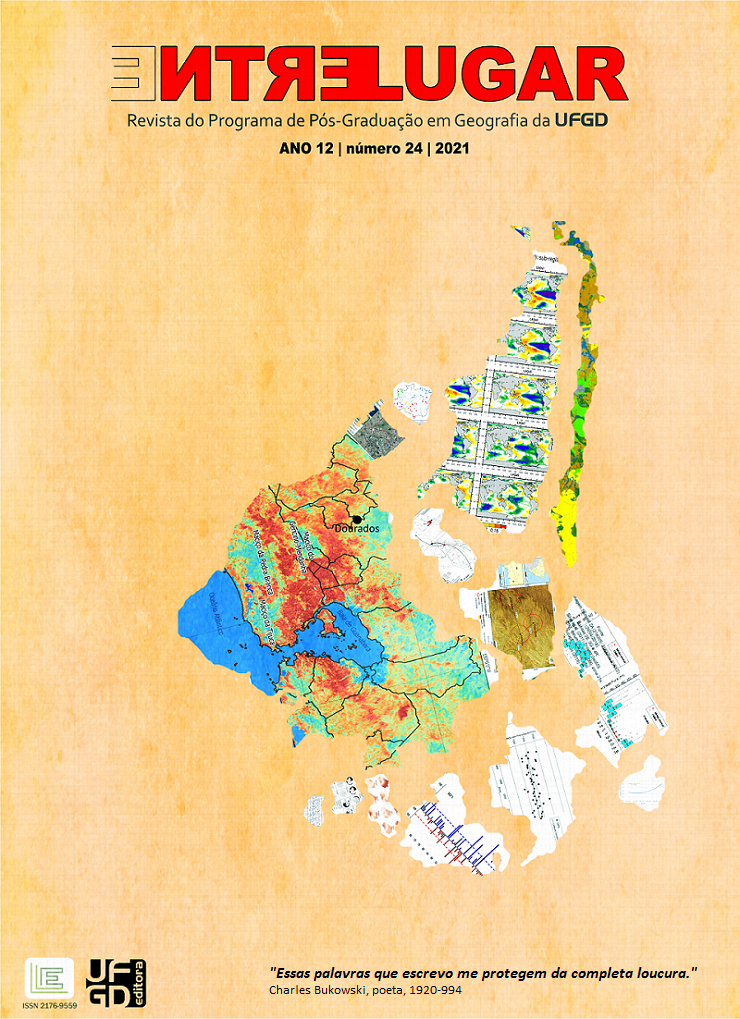Teleconexões atmosféricas e vazão fluvial na Bacia Amazônica Brasileira por meio de mapas de correlação linear
DOI:
https://doi.org/10.30612/rel.v12i24.15158Palabras clave:
técnica de cluster, sub-região Norte, sub-região Sul, correlação linear, temperatura da superfície do mar.Resumen
Na presente pesquisa objetiva-se compreender como diferentes padrões de teleconexões atmosféricas atingem diferentes áreas da bacia amazônica brasileira. Para isso, foram utilizadas as técnicas estatísticas de análise de cluster para definição de áreas homogêneas de variabilidade de vazão dos rios amazônicos. Foram definidas cinco sub-regiões: Norte, Amazonas-Foz, Oeste, Sul e Central. Para compreender a associação entre a variabilidade da vazão e sua associação com anomalias da temperatura da superfície dos mares globais foram calculados os mapas de correlação linear com defasagem temporal entre as variáveis para as sub-regiões Norte e Sul. As duas sub-regiões apresentaram valores distintos nos mapas de correlação linear com defasagem temporal, indicando que a aplicação dessa técnica é adequada para identificação de áreas oceânicas correlacionadas com variáveis hidrometerológicas nos continentes. A sub-região Norte apresentou associação maior com o Pacífico enquanto a sub-região Sul, com o Atlântico.
Descargas
Citas
AMBRIZZI, T. El Niño/Oscilação Sul e teleconexões atmosféricas no hemisfério austral. São Paulo: USP/IAG, 2003. (Tese de Livre-Docência).
BLACKMON, M.L., LEE, Y.-H; J.M.; WALLACE, J.M.: Horizontal structure of 500 mb height fluctuations with long, intermediate and short time scales. Journal of Atmospheric Science, vol. 41, p. 961-979, 1984a.
___, ____, ____; HSU, H. -H. Time variations of 500 mb height fluctuations with long, intermediate, and short time scales as deduced from lag correlation statistics. Journal of Atmospheric Science, vol. 41, p. 981-991, 1984b.
DESER, C.; ALEXANDER, M. A.; XIE, S.-P.; PHILLIPS, A.S. Sea Surface Temperature variability: patterns and mechanisms. Annual Review of Marine Science. Vol. 2, p. 115-143, 2010.
ESPINOZA, J.C. et al. The extreme 2014 flood in south-western Amazon basin: the role of tropical-subtropical South Atlantic SST gradient. Environmental Research Letters. Vol. 9, p. 124007 (9p.), 2014.
GRIMM, A.M.; AMBRIZZI, T. Teleconnections into South America from the Tropics and Extratropics on Interannual and Intraseasonal timescales. In__: VIMEUX, F.; SYLVESTRE, F.; KHODRI, M. Past climate variability in South America and Surrounding Regions: from the last glacial maximum to the Holocene. 14ª ed. USA: Springer, 2009, p. 159-191.
HAIR, J.F. et al. Análise multivariada de dados. 5a. ed. Porto Alegre: Bookman, 2005.
HOREL, J.D.; WALLACE, J.M. Planetary-Scale Atmospheric Phenomena associated with the Southern Oscillation. Monthly Weather Review. Vol. 109, p. 813-89, abr. 1981.
HOSKINS, B.J. et al. Energy dispersion in a barotropic atmosphere. Quarterly Journal of Royal Meteorological Society. Vol. 103, p. 553-567, 1977.
HOSKINS, B.J.; KAROLY, D. The steady linear response of a spherical atmosphere to thermal and orographic forcing. Journal of Atmosphere Science. Vol. 38, p. 1179-1196, 1981.
HOSKINS, B.J. Dynamical processes in the atmosphere and the use of models. Quarterly Journal of Royal Meteorological Society. Vol. 109, p.1–21, 1983.
KAGAN, B. A. Ocean-atmosphere interaction and Climate Modeling. Tradução M. A. Chazin. Cambridge: Cambrigde University Press, 1995.
KALNAY, E. The NCEP/NCAR 40-year Reanalysis Project. Bulletin of the American Meteorological Society. Vol. 77, n. 3, p.437-471, mar. 1996.
LINAGE, C. de; FAMIGLIETTI, J.S.; RANDERSON, J.T. Statistical prediction of terrestrial water storage changes in the Amazon Basin using tropical Pacific an North Atlantic sea surface temperatures anomalies. Hydrology and Earth System Sciences. Vol. 18, p. 2089-2102, 2014.
MARENGO, J.A. et al. The drought of Amazonia in 2005. Journal of Climate. Vol. 21, p. 495-516, feb. 2008.
MÉLICE, J.-L; SERVAIN, J.. The tropical Atlantic meridional SST gradient index and its relationships with the SOI, NAO and Southern Ocean. Climate Dynamics. N. 20, p. 447–464, 2003.
PEZZA, A.B.; RASHID, H.A.; SIMMONDS, I. Climate links and recent extremes in antarctic sea ice, high-latitude cyclones, Southern Annular Mode and ENSO. Climate -Dynamics. Vol. 38, p. 57-73, 2012.
PINTO, N.L.S.(org.) Hidrologia Básica. São Paulo: Edgard Blücher, 1976.
SIMMONS, A.J. The forcing of stationary wave motion by tropical diabatic heating. Quarterly Journal of Royal Meteorological Society. Vol. 108, p. 503-534, 1982.
SIMMONS, A.J. et al. Barotropic wave propagation and instability, and atmospheric teleconnection pattern. Journal of Atmospheric Sciences. Vol. 40, n. 6, p. 1363-1391, jun. 1983.
WALLACE, J.M.; GUTZLER, D.S. Teleconnections in the geopotential height field during the Northern Hemisphere winter. Meteorological Weather Review. Vol. 109, p. 785-812, 1981.
WELLS, N. The atmosphere and ocean: a physical introduction. 2ªed. Chichester: John Wiley & Sons, 1998.
WILKS, D.S. Statistical Methods in the Atmospheric Sciences. 2ª ed. San Diego - CA: Elsevier, 2006.
Descargas
Publicado
Cómo citar
Número
Sección
Licencia
Autores que publicam nesta revista concordam com os seguintes termos:
- Autores mantém os direitos autorais e concedem à revista o direito de primeira publicação, com o trabalho simultaneamente licenciado sob a Creative Commons Atribuição-NãoComercial-CompartilhaIgual 3.0 Brasil que permitindo o compartilhamento do trabalho com reconhecimento da autoria do trabalho e publicação inicial nesta revista.
- Autores têm autorização para assumir contratos adicionais separadamente, para distribuição não-exclusiva da versão do trabalho publicada nesta revista (ex.: publicar em repositório institucional ou como capítulo de livro), com reconhecimento de autoria e publicação inicial nesta revista.
- Autores têm permissão e são estimulados a publicar e distribuir seu trabalho online (ex.: em repositórios institucionais ou na sua página pessoal) a qualquer ponto antes ou durante o processo editorial, já que isso pode gerar alterações produtivas, bem como aumentar o impacto e a citação do trabalho publicado (Veja O Efeito do Acesso Livre).




